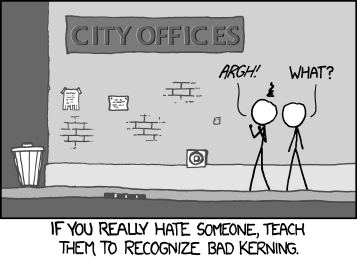When Space and Physics Don’t Mix
Hi!
A warning before you read today’s email any further: I’m going to show you something annoying that you may have never noticed before. But once I show you, you’ll start noticing it here and there — not everywhere, thankfully! — and it’ll bother you every time. It’s not gross. It’s totally safe for work. It’s G-rated. It’s just annoying.
It’s called “kerning.” That’s a typographical term — it means, basically, “the spacing between letters.” And this is your final warning before it becomes a minor point of frustration in your life.
Why am I sharing this? Because two people, independently, emailed me this week about a story about bad kerning. It’s something I happened to have already shared in my second book (on page 71-72 if you have a copy), but I didn’t actually use the word “kerning” in the story. So, I’ll share it again — if you’re willing, that is. As the title above notes, this newsletter is about “space” and “physics.” Let’s start with the “space” part and move on to the “physics” part after.
Still here? Let’s go.
In general, we don’t think about the space between letters, but that’s because it’s usually good. But when it’s not quite right, you probably notice that something is a bit amiss. Here’s an example from a pair of baseball uniforms. The guy on the left, Vladimir Guerrero Jr., is a great player for the Toronto Blue Jays, and his uniform looks equally great. The player on the right, Julio Rodríguez, is a great player for the Seattle Mariners, and his uniform looks awful — if you know what to look at.

The issue is the spacing between the second “R” and the “Í” — there’s just too much space there. The Mariners navy uniforms somewhat famously have terrible kerning, as least among those of us who know about kerning. There are a lot of other examples in the world, some of which have PG-13 results, and in order to keep this email family-friendly, I’ll leave it to you to Google for them yourself.
The thing about kerning, though, is that you tend not to really notice it if you don’t know that it’s a thing. My warning at the top was kind of jokey, of course, but it’s also kind of true. Here’s an xkcd comic whose point I echoed, and — had I not just told you about bad kerning, you probably would have shared the reaction of the person on the right. (From now on, you’re the person on the left. Sorry, but I warned you.) And for the record, I do not really hate any of you. The opposite, if anything!

Okay, so what does this physics? Well, for a while, if you cracked open a dictionary, you’d see that the word “dord” was in there. But “Dord” is not a word today, and usually, words don’t just stop being words. The issue, most likely, was good kerning that someone thought was bad kerning. Here’s what I wrote in my book. (I added some links so you can see pictures of this in action.)
[The term “dord” came to us] courtesy of the G. and C. Merriam Company (a predecessor of Merriam-Webster). Dord first appeared in its 1934 edition of the “New International Dictionary” as a noun from the disciplines of physics or chemistry meaning, simply, “density.” The error was due to odd typesetting at the time. The entry was supposed to be for “D or d” — that is, a capital or lower-case letter D — noting that either could be used, in physics or chemistry, as an abbreviation for “density.” [You can see how it was submitted originally, via Merriam-Webster, here.] But the entry was set as “D o r d,” and a later editor simply removed what appeared to be three unnecessary spaces [seen here].
“Dord” remained in subsequent editions through 1939, when a proofreader realized that the word lacked an etymology, and called its veracity into question. Other dictionaries used the word until 1947, likely having copied from old dictionaries (including, perhaps, those of competitors).
Oops.
The Now I Know Week in Review
Monday: Why Beer Comes in Brown (or Green) Bottles: Light and beer mix worse than space and physics.
Tuesday: One Man’s Trash Is Another Man’s … Hobby?: And it’s a good hobby for the community, too!
Wednesday: When Golf Gave a Hoot: Birds and birdies?
Thursday: How the House at Pooh Corner Got Built: The song has been stuck in my head for a day, but I guess I don’t have anyone to blame for that but myself. Oh, a quick correction here, too — apparently, the Nitty Gritty Dirt Band did end up recording the song; I just missed it. Thank you to everyone who wrote in to let me know I messed up!
And some other things you should check out:
Some long reads for the weekend:
1) “How Linus Pauling duped America into believing vitamin C cures colds” (Vox, 8 minutes, February 2015). Per the article, “everything we know about research shows that mega-doses of vitamin C are absolutely, positively useless at fighting colds. All that extra orange juice will do nothing to shorten your sniffles.” That surprised me, as did this whole article.
2) “The Disaster Consultants” (The Verge, 17 minutes, August 2022). When disaster strikes, there’s government aid (in the U.S., at least) to help towns rebuild. But small-town mayors don’t know how to navigate the process. This is the story about the experts they hire: the people who, as the article describes them are “like accountants but for a hurricane” who “know all the rules and regulations” and “help with the paperwork.”
3) “Inside One Man’s Quest to Taste Every Fruit on Earth” (Atlas Obscura, 6 minutes, October 2020). It’s going to take him a while; there are a lot of different fruits out there.
Have a great weekend!
Dan
